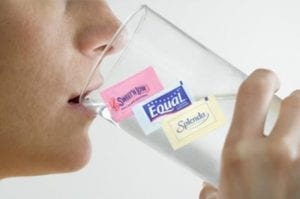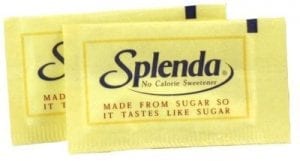(Splenda) A chlorinated sucrose derivative derived from sugar, but 600 times sweeter than sugar that was originally found through the development of a new insecticide compound and wasn’t originally intended to be consumed. Linked to Leukemia, obesity, diabetes, and toxicity.
Would you intentionally eat a substance that when exposed to your eyes, essentially burns them and turns them blazing red?
Or how about a substance that has been used as a chemical warfare agent as far back as World War I and as recently as the Iraq war?
Well, each and every day many of you reading this do this very thing – only you have absolutely NO idea you are consuming this toxic substance.
And in fact, this very same substance has been touted as actually being healthy for you!
Get ready to be surprised.
Poison in Our Food?
In our never-ending quest to get something for nothing, food manufacturers continue to search for sugar alternatives. The most recent is touted as “tasting like sugar because it comes from sugar.” Yep, Splenda.
Splenda (known also as sucralose) is made by replacing two of the molecules from table sugar with chlorine. Yes, you read that right…it contains chlorine… the very same substance that’s been used as a chemical warfare agent and that’s routinely used to disinfect pools that our children swim in.
The resultant Splenda sugar replacement is a substance that is 600 times sweeter than sugar. And herein lies the problem.
On one side, you have Splenda advocates saying that sucralose is completely safe. On the other side you have those who say the dangers of Splenda are quite plentiful. So who’s right?
The Dangers of Splenda…
Let’s start with the history of sucralose. Like saccharine and aspartame, sucralose was also accidentally discovered…while trying to create an insecticide. Clue number one.
Clue number two is the high number of sucralose side effects.1 Those most frequently noted include:
- Headaches
- Skin irritation
- Coughing
- Runny nose
- Heart palpitations
- Depression and mood swings
- Digestive issues
- Itchy eyes
In fact, headaches may be an understatement. According to a 2006 issue of the journal Headache, researchers noted that there was “potential causal relationship” between sucralose and migraines.2 Interestingly, researchers also indicated that sucralose was approved by the FDA on April 1, 1998, taking time to note that this is April Fool’s Day!
Then there are the more serious side effects. According to a 1990 study from Food and
Chemical Toxicology, rats given sucralose had increased incidents of enlargement of the caecum (the first section of the large bowel), pelvic epithelial hyperplasia (precancerous cells of the pelvis), and renal mineralization (accumulation of mineral in the kidneys).3
In a 2008 study from Duke University and published in the Journal of Toxicology and Environmental Health, researchers found that rats given sucralose for 12 weeks were found to be more prone to obesity, less healthy intestinal bacteria, and poor absorption of prescription drugs.4
While this study does show some pretty severe Splenda-related side effects, we do have to note that the study was funded by the sugar industry, which can cast some doubt on the results.
Then there’s the study done by the manufacturers of sucralose itself that found that rats given sucralose had 40 percent shrinkage of the thymus gland, which produces T-cells and is vital for a health immune system. They also found that the sugar replacement caused enlargement of the liver and kidneys.5 This is especially problematic, given that your liver and kidneys are two of your body’s primary organs for detoxification.
Just don’t bother trying to find this study in any peer-reviewed journals. See, the findings were discovered in a pre-approval study, and for what appears to be obvious reasons, the manufacturer opted not to publish the study.
Still, one can raise the valid issues that these studies are animal studies. What about humans? Great question. Wish we could answer it for you.
The reality is, as of 2006, only six human trials have been published on sucralose, and of these, only two were published before the FDA granted approval to Splenda. Additionally, those two trials were only done on a total of 36 people.
And, of the total human studies, the longest one lasted a grand total of four days. Yep, that’s less than 100 hours.
Which then begs the question, what are the positives associated with Splenda?
Is Splenda Safe…
According to the FDA, “In determining the safety of sucralose, the FDA reviewed data from more than 100 studies in humans and animals. Many of the studies were designed to identify possible toxic effects, including carcinogenic, reproductive, and neurological effects. No such effects were found.”6
Of course, they fail to mention that only two of the studies at the time were human studies.
On the research front, several additional animal studies have found that sucralose poses no risk. In a 2000 study from Food and Chemical Toxicology, researchers fed three different dosages of sucralose to three groups of rats. They found negative side effects at all three levels.7
The group that received 1,150 times the estimated daily intake (EDI) of sucralose exhibited kidney weight and decrease thymus weights in the offspring, as well as that offspring’s offspring. All three groups (the other two took 100 times the EDI and 365 times the EDI) showed caecal enlargement (the first section of the large bowel) in both the rats that received the Splenda, as well as their offspring.
Yet, researchers didn’t mention this in their conclusion. Instead, they concluded that sucralose had no effect on glucose metabolism in sperm nor on male or female reproductive performance in rats.
What? Perhaps their argument is that the amount given was so high that it didn’t warrant comment. But they failed to determine (and continue to fail to determine) the long-term, cumulative effects of sucralose consumption.
In a human study (yes, human!), researchers tested the effects of Splenda on appetite. They conducted a randomized, single-blinded, crossover study in eight healthy subjects. Participants were studied on four different days. They drank either plain water, sucralose, a sweetened drink similar in taste to sucralose, or a modified sham-feeding of sucralose (the sucralose never hits the stomach).8
They found that drinking sucralose did not reduce insulin levels. This is good, right? But the study also found that sucralose had no effect on appetite. The reality is that the sucralose did not reduce appetite. In other words, consuming Splenda did not make the participants eat less food.
Which, of course, leads us to the biggest purported benefit of all…weight loss. Splenda is marketed as the “no calorie sweetener.” Of course, this is meant to attract those people looking to lose weight. And the fact that it is a sugar alternative is meant to appeal to diabetics and those looking to reduce their sugar intake.
Here’s the problem. There actually ARE calories in Splenda. In fact, there are 96 calories in a cup. And one little yellow packet contains four calories. Wait, what?
Yes, that’s right. According to their own Web site, the “no calorie” sweetener contains “less than 5 calories, which meets FDA’s standards for no-calorie foods.”
So four calories is actually no calories? If you can figure out how that makes sense, please let us know.
Trust Your Gut…
So where do we go from here? Trust the FDA when they say Splenda is safe? Trust the company’s own contradictory message regarding calories?
Or do you trust the studies that show a likely health risk, including a study done by the makers of the sugar replacement itself?
Once again, this is where you need to use common sense. When in doubt, go natural. Time and time again, the food industry has proven that it’s typically just a matter of time before whatever Franken-chemical they’ve created ultimately proves to be dangerous, one way or another.
So, play it safe, and opt instead for naturally sweet foods like berries and cherries to feed your sweet tooth. And if you must have a little extra kick, aim for stevia.
As we’ve indicated before, stevia has been shown to improve insulin sensitivity rather than decrease it.9 So stick with the natural and leave the chlorine in the pool.
References:
- Kovacs, Betty. http://www.medicinenet.com/artificial_sweeteners/page9.htm. 12/13/2010.
- Patel, RM et al. Popular sweetener sucralose as a migraine trigger. Headache. 2006 Sep;46(8):1303-4.
- Lord, GH and Newberne, PM. Renal mineralization – a ubiquitous lesion in chronic rat studies. Food Chem Toxicol. 1990 Jun;28(6):449-55.
- Abou-Donia, MB et al. Splenda alters gut microflora and increases intestinal p-glycoprotein and cytochrome p-450 in male rats. J Toxicol Environ Health A. 2008;71(21):1415-29.
- New Scientist. November 23, 1991. Page 13.
- Sucralose. FDA Final Rule. United States: Food and Drug Administration. www.cfsan.fda.gov/~lrd/fr900403.html.
- Kille, JW et al. Sucralose: lack of effects on sperm glycolysis and reproduction in the rat. Food Chem Toxicol. 2000;38 Suppl2:S19-29.
- Ford, HE et al. Effects of oral ingestion of sucralose on gut hormone response and appetite in healthy normal-weight subjects. Eur J Clin Nutr. 2011 Apr;65(4):508-13.
- Lailerd, N et al. Effects of stevioside on glucose transport activity in insulin-sensitive and insulin-resistant rat skeletal muscle. Metab. Clin. Exp. 2004 Jan;53(1):101-7.
Chronology of Events Related to Sucralose

Study: Drinking Two or More diet Beverages a Day linked to High Risk of Stroke, Heart Attacks

Study: Artificially Sweetened Drinks put people at a Greater Risk of Developing Type 2 Diabetes

Six FDA Approved Artificial Sweeteners Proven Toxic To Human Digestion

New Study Finds Sucralose Is Metabolized and Stored in Your Body




